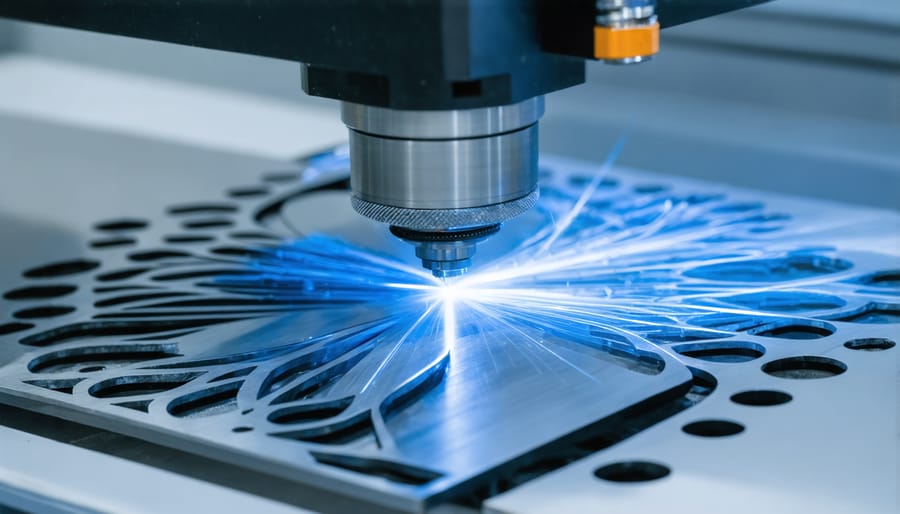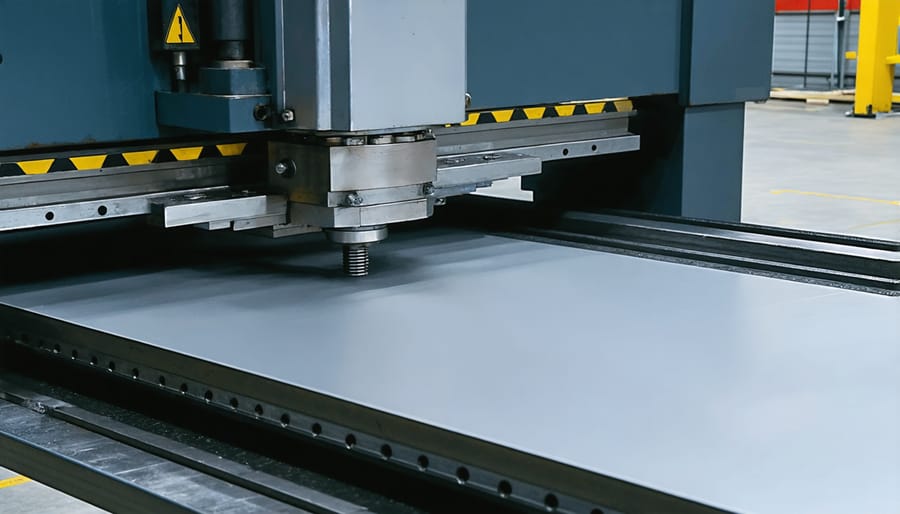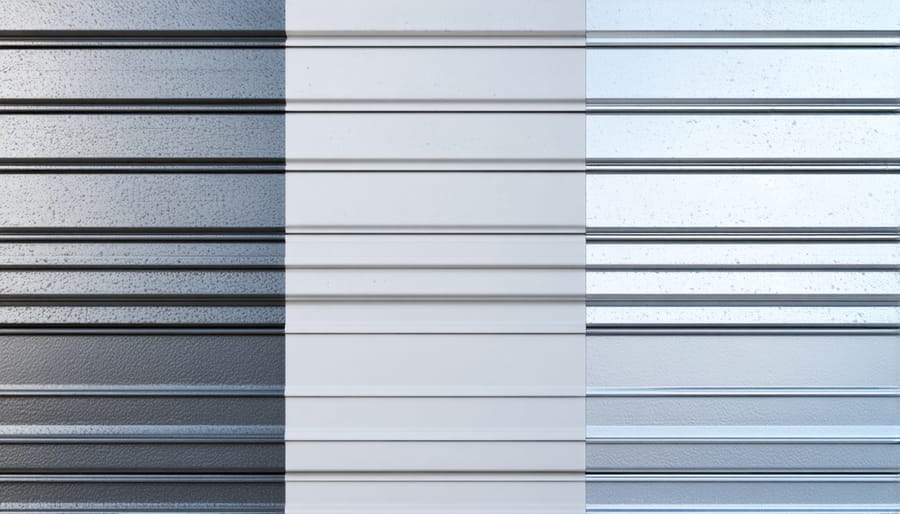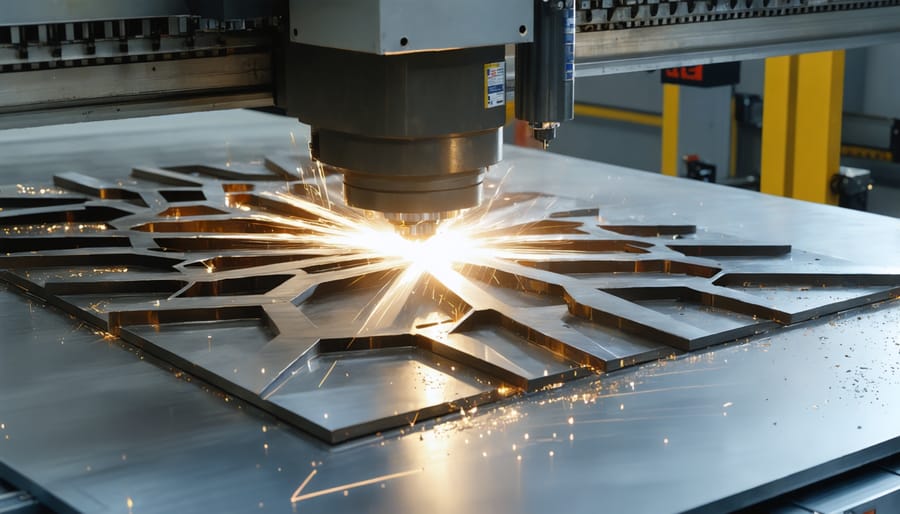Sheet metal fabrication revolutionizes modern manufacturing through precision, versatility, and efficiency. From aerospace components to architectural elements, modern fabrication techniques transform raw metal sheets into sophisticated products that shape our industrial landscape.
Master fabricators combine traditional craftsmanship with cutting-edge technology to bend, cut, and form metal sheets with microscopic precision. Computer Numerical Control (CNC) machinery, laser cutting systems, and advanced forming processes now enable unprecedented accuracy and complexity in metal fabrication, while reducing material waste and production time.
Whether crafting intricate HVAC components or structural building elements, today’s sheet metal fabrication demands a thorough understanding of both material properties and manufacturing methodologies. This comprehensive guide explores essential techniques, from basic cutting and forming operations to advanced welding and finishing processes, empowering fabricators to deliver superior results across diverse applications.
The systematic approach to sheet metal work, grounded in engineering principles and enhanced by technological innovations, ensures consistent quality and remarkable versatility in modern manufacturing environments.
Essential Sheet Metal Cutting Techniques
Shearing and Punching
Shearing and punching are fundamental mechanical cutting methods in sheet metal fabrication. Shearing involves using parallel blades to create straight cuts across metal sheets, similar to how scissors work but on an industrial scale. The upper blade moves downward against a stationary lower blade, cleanly separating the material along the cutting line.
Punching, on the other hand, uses specialized tools to create holes or specific shapes in the metal. A punch press forces a shaped tool through the material and into a matching die beneath, effectively stamping out the desired pattern. This process can create both simple round holes and complex geometric shapes, depending on the tooling used.
Both techniques offer fast, economical cutting solutions for high-volume production. While shearing is limited to straight cuts, it excels in speed and precision for large sheets. Punching provides versatility in creating various openings and patterns but requires specific tooling for each shape. These methods typically produce clean edges, though some deformation may occur at the cut line, which should be considered during design planning.
Laser and Plasma Cutting
Laser and plasma cutting represent the cutting edge of modern manufacturing processes in sheet metal fabrication. These technologies offer unprecedented precision and efficiency, with laser cutting capable of achieving tolerances as tight as 0.1mm. Laser cutting uses a focused beam of light to melt or vaporize material, creating clean, precise cuts with minimal heat-affected zones. This method is ideal for intricate designs and complex patterns, particularly in thinner materials up to 1/2 inch thick.
Plasma cutting, while slightly less precise, excels at cutting thicker materials and operates at higher speeds. It works by directing a high-temperature plasma torch at the metal, which melts through the material while a high-pressure gas removes the molten metal. This technique is particularly cost-effective for cutting steel plates up to 2 inches thick.
Both methods are computer-controlled, ensuring consistent quality and repeatability across production runs. They eliminate the need for mechanical tooling and can seamlessly transition between different cutting patterns without setup changes, making them ideal for both prototype development and high-volume production.

Manual and Power Cutting Tools
Manual cutting tools like aviation snips, tin snips, and hand shears remain essential for precise, detailed work in sheet metal fabrication. These tools allow craftsmen to make intricate cuts and work in tight spaces where power tools might be impractical. Aviation snips, available in straight, left-cut, and right-cut variations, excel at creating curved and straight cuts in lighter gauge metals.
Power tools significantly increase cutting efficiency and capability. Electric shears and nibblers can handle thicker materials while providing clean, precise cuts. The versatile angle grinder, equipped with appropriate cutting discs, proves invaluable for both straight cuts and detail work. For high-volume production, powered Beverly shears offer quick, accurate cuts while maintaining material integrity.
When selecting cutting tools, consider factors like material thickness, cut complexity, and project scale to determine the most suitable option.
Forming and Bending Methods
Press Brake Operations
Press brake operations are fundamental to modern sheet metal bending techniques, allowing fabricators to create precise angles and forms in metal sheets. The process involves positioning metal between a punch and die, then applying controlled pressure to achieve the desired bend. Common applications include creating box shapes, channels, and complex architectural components.
Most press brake operations utilize air bending, where the metal is bent without fully compressing it against the die, or bottoming, where the material is pressed completely into the die shape. The choice between these methods depends on factors like material thickness, required accuracy, and the final application.
Operators must consider bend allowance and spring-back when planning their bends. Spring-back occurs when metal naturally tries to return to its original shape after bending, requiring overbending to achieve the target angle. Modern press brakes often feature CNC controls and back gauges for precise, repeatable results, making them essential for both small-scale production and large manufacturing operations.

Roll Forming
Roll forming is a highly efficient, continuous process used to transform flat sheet metal into long, uniform profiles with consistent cross-sections. This technique is particularly valuable for producing large quantities of items like metal roofing, wall panels, gutters, and structural components.
During roll forming, sheet metal passes through a series of paired rollers, each set gradually bending the material into the desired shape. The rollers are arranged in stations, with each station incrementally forming the metal until it achieves the final profile. This progressive forming approach helps prevent material distortion and ensures uniform quality throughout the length of the product.
One of the key advantages of roll forming is its ability to handle high-volume production runs with minimal material waste. The process can accommodate various metal thicknesses and types, including steel, aluminum, and copper. Modern roll forming lines often integrate additional operations like punching, cutting, and embossing, creating finished products in a single pass.
For manufacturers requiring long, continuous profiles with tight tolerances, roll forming offers exceptional consistency and cost-effectiveness compared to other fabrication methods.
Stamping and Deep Drawing
Stamping and deep drawing are powerful sheet metal fabrication techniques used to create complex three-dimensional shapes from flat metal sheets. In stamping, a mechanical press uses specialized dies to form, cut, or shape the metal through controlled force application. This process is particularly efficient for high-volume production runs and can create intricate details, logos, and textures in a single operation.
Deep drawing takes metal forming a step further by pulling sheet metal into a forming die with a punch, creating deep, hollow shapes like cups, pans, and automotive body panels. The process begins with a flat blank that’s progressively drawn into the desired form while maintaining material thickness. Successful deep drawing requires careful consideration of material properties, draw ratios, and proper lubrication to prevent defects like wrinkling or tearing.
Both techniques are essential in manufacturing consumer goods, automotive components, and industrial products. Modern stamping and deep drawing operations often utilize computer-controlled equipment and advanced simulation software to optimize tool design and process parameters, ensuring consistent quality and reducing material waste.
Joining and Assembly Techniques
Welding Processes
Welding plays a crucial role in modern precision fabrication methods for sheet metal. The most common techniques include MIG (Metal Inert Gas) welding, which offers excellent control and clean welds for thin materials. TIG (Tungsten Inert Gas) welding provides superior accuracy and is ideal for delicate sheet metal work, particularly with aluminum and stainless steel. Spot welding, frequently used in automotive applications, creates strong, localized bonds between overlapping sheets.
For thinner gauges, resistance seam welding creates continuous, water-tight joints, making it perfect for tanks and containers. Laser welding has gained popularity for its precision and minimal heat-affected zone, reducing material distortion. Each method has specific advantages depending on factors like material thickness, type, and project requirements.
When selecting a welding process, consider the material composition, required joint strength, and aesthetic requirements. Proper preparation and temperature control are essential to prevent warping and ensure structural integrity.
Mechanical Fastening
Mechanical fastening methods provide reliable and often permanent solutions for joining sheet metal components. Riveting stands as one of the most common techniques, offering strong, durable connections that can withstand significant stress. Cold riveting works well for thin sheets, while hot riveting is preferred for heavier gauge materials and structural applications.
Bolting presents another versatile joining option, allowing for both permanent and temporary connections. Self-tapping screws are particularly useful in sheet metal work, eliminating the need for pre-drilled holes in many applications. When selecting bolts, consider factors like material thickness, load requirements, and environmental conditions.
Other mechanical joining methods include clinching, which creates a permanent connection by deforming the metal sheets together without additional fasteners, and snap-lock systems that enable quick assembly and disassembly. These techniques often prove cost-effective as they require no additional materials beyond the sheet metal itself.
For optimal results, proper hole preparation and alignment are crucial. Always consider the application requirements, material properties, and accessibility when choosing a mechanical fastening method. Some applications may benefit from combining different fastening techniques to achieve the desired strength and durability.
Adhesive Bonding
Modern adhesive bonding has revolutionized sheet metal fabrication by offering strong, clean, and efficient joining solutions. High-performance structural adhesives provide excellent strength while eliminating the need for mechanical fasteners or welding. These adhesives distribute stress evenly across joints, reduce material distortion, and prevent galvanic corrosion between dissimilar metals.
Common adhesive types include epoxies, acrylics, and polyurethanes, each suited for specific applications. Epoxies offer superior strength and chemical resistance, while acrylics provide rapid curing and good impact resistance. Polyurethanes excel in flexibility and weathering resistance.
The success of adhesive bonding depends on proper surface preparation, including cleaning, degreasing, and sometimes surface treatment. Modern adhesives can bond different materials together, making them invaluable for composite assemblies and lightweight construction.
Finishing and Surface Treatment

Protective Coatings
Protective coatings play a crucial role in extending the lifespan and enhancing the appearance of sheet metal products. Paint application offers versatile color options and corrosion resistance, typically applied through spray systems or electrostatic methods for even coverage. Modern industrial paints are specifically formulated for metal surfaces, providing excellent adhesion and durability.
Powder coating has become increasingly popular due to its superior durability and environmental benefits. This process involves applying dry powder electrostatically to the metal surface, followed by curing in an oven where the powder melts and forms a uniform, hard finish. Powder-coated surfaces are highly resistant to chipping, scratching, and fading, making them ideal for outdoor applications.
Galvanization provides exceptional corrosion protection by coating steel or iron with a layer of zinc. Hot-dip galvanizing, the most common method, involves immersing metal parts in molten zinc, creating a metallurgical bond that offers long-lasting protection. This process is particularly effective for outdoor and marine applications where exposure to harsh elements is a concern.
Each coating method has specific preparation requirements, including thorough cleaning, degreasing, and sometimes surface treatment to ensure proper adhesion and optimal performance. The choice of coating depends on factors such as environmental exposure, aesthetic requirements, and budget considerations.
Surface Preparation
Proper surface preparation is crucial for achieving high-quality sheet metal fabrication results. The process typically begins with thorough cleaning to remove oils, dirt, and manufacturing residues that could interfere with subsequent processes. Common cleaning methods include solvent wiping, alkaline washing, or vapor degreasing, depending on the metal type and level of contamination.
Deburring is an essential step that removes sharp edges and metal burrs created during cutting operations. This can be accomplished using various tools, including file sets, deburring wheels, or specialized deburring machines. The choice of deburring method depends on the material thickness and production volume.
Surface preparation may also involve removing oxide layers or scale, particularly on materials like stainless steel or aluminum. This can be achieved through mechanical methods such as grinding, sanding, or blast cleaning, or chemical processes like acid pickling.
For projects requiring painting or coating, proper surface roughness is critical for adhesion. Light abrasive blasting or chemical etching may be necessary to create an optimal surface profile. Additionally, some applications may require masking certain areas to protect them during subsequent processing steps.
Finally, all prepared surfaces should be inspected for cleanliness, smoothness, and dimensional accuracy before proceeding with further fabrication steps.
Sheet metal fabrication encompasses a diverse range of techniques that require both precision and expertise. Throughout this exploration of fabrication methods, we’ve covered essential processes from basic cutting and forming to advanced finishing techniques. The key to successful sheet metal fabrication lies in selecting the appropriate method for each specific project while maintaining strict quality control standards.
Best practices in sheet metal fabrication include careful material selection, precise measurement and marking, and proper tool maintenance. Industry professionals should always prioritize safety protocols, particularly when operating automated machinery or performing manual cutting operations. Regular calibration of equipment and thorough quality checks at each stage of fabrication ensure consistent, high-quality results.
The evolution of technology continues to reshape the industry, with CNC machines and automated systems offering enhanced precision and efficiency. However, traditional manual techniques remain valuable, especially for custom or small-batch projects. Whether utilizing modern or conventional methods, attention to detail and proper planning are crucial for successful outcomes.
For optimal results, fabricators should maintain updated knowledge of industry standards, invest in proper training, and carefully document their processes. Environmental considerations and waste reduction strategies should also be integrated into fabrication operations, promoting sustainability while maintaining cost-effectiveness.
As the industry advances, combining time-tested techniques with innovative technologies will continue to drive excellence in sheet metal fabrication, ensuring the delivery of high-quality, precise, and durable products.










